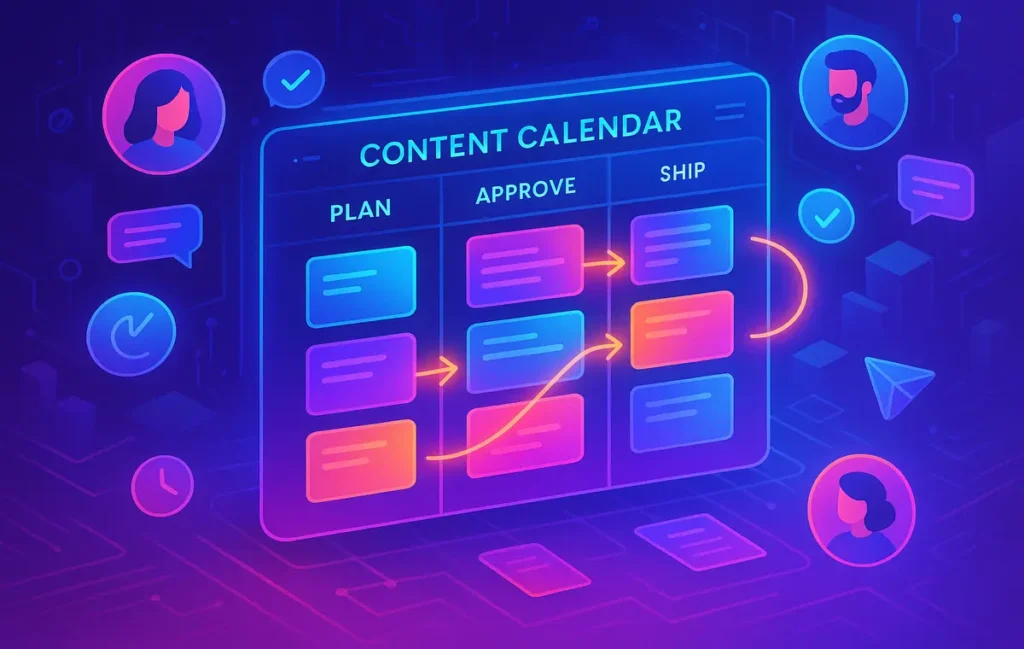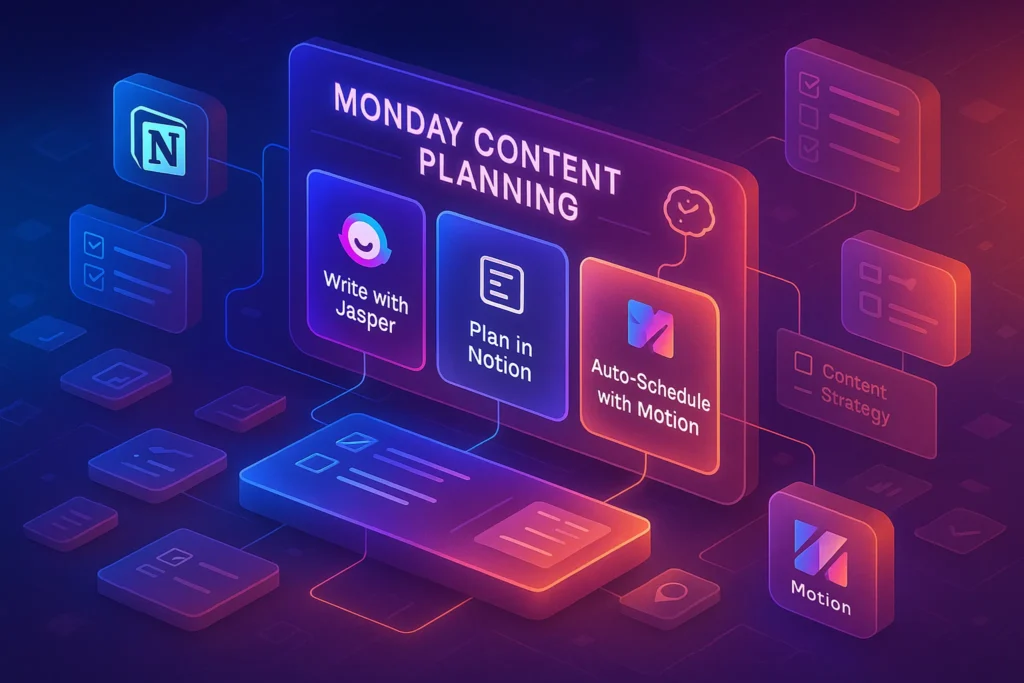🚧 The Chaos of Content Without a Calendar
Every content team knows the feeling: too many ideas, endless revisions, and deadlines slipping through the cracks. Without a proper content calendar, campaigns become chaotic. Blog posts overlap, social media messages get delayed, and approvals drag on for weeks.
A good content calendar solves these pain points by bringing visibility, accountability, and structure to the entire process. Instead of managing projects in scattered docs or chat threads, you manage the full cycle: Plan → Approve → Ship.
💡 Nerd Tip: Content calendars are more than “pretty schedules.” They’re workflow engines that transform messy teams into publishing machines.
If you’re already exploring bigger platforms, our Content Marketing Platforms guide explains how calendars connect to analytics, campaign tracking, and creative asset management.
🧭 Why a Content Calendar Matters
A content calendar isn’t just about deadlines—it’s about trust. Teams that operate with calendars have:
-
Consistency: Publishing on schedule builds audience loyalty.
-
Visibility: Everyone knows what’s coming next.
-
Accountability: Roles and tasks are clear, making bottlenecks obvious.
Research from CoSchedule shows that marketers with a documented content plan are 60% more likely to be effective. The difference isn’t creativity; it’s organization.
💡 Nerd Tip: A calendar gives your stakeholders peace of mind. Executives don’t want to hear excuses—they want to see a roadmap.
For teams experimenting with automation in planning, our How to Automate Content Planning with AI Tools breaks down how AI can suggest optimal posting times, formats, and topics.
📝 Plan: Organizing Ideas & Scheduling
The planning stage is where chaos either starts or stops. Good content calendar tools let you capture ideas, prioritize them, and transform them into scheduled deliverables.
Key features to look for:
-
Templates: Reusable campaign and post templates save time.
-
Multi-channel planning: Schedule across blogs, social media, email, and video in one dashboard.
-
AI-assisted scheduling: Modern tools use algorithms to recommend publish times based on engagement data.
A strong planning system prevents double-booking and aligns creative resources with deadlines. For example, using Notion or Asana for planning ensures writers, designers, and marketers all see the same roadmap.
💡 Nerd Tip: Tag content by campaign or funnel stage. This helps balance top-of-funnel and bottom-of-funnel content across weeks.
Our Monday Content Planning post goes deeper into how structured planning frameworks reduce decision fatigue in growing teams.
✅ Approve: Keeping Stakeholders Aligned
The hardest part of content workflows isn’t writing—it’s approvals. Waiting days for a manager or legal team to review can delay campaigns. That’s why advanced content calendars now include approval workflows.
Key features include:
-
Role-based permissions: Assign editors, reviewers, and publishers.
-
Real-time collaboration: Stakeholders comment directly on drafts.
-
Feedback loops: Instead of endless email chains, revisions live inside the platform.
This makes approvals faster and transparent. No one can claim they “didn’t see the draft” when every update is logged. Approval flows are especially crucial for industries like finance or healthcare, where compliance requires multiple sign-offs.
💡 Nerd Tip: Define SLA (Service Level Agreement) times for approvals—like 48 hours max. This keeps bottlenecks predictable.
If you’re new to the concept of structured planning, it’s worth starting with the basics. A calendar isn’t just a scheduling tool—it’s a framework for consistency, accountability, and creative flow. Our detailed guide, Content Calendar 101, walks through the fundamentals step by step, from simple spreadsheets to advanced team platforms. Reading that alongside this review ensures you not only choose the right tool, but also understand the mindset that makes calendars effective.
🚀 Ship: Publish with Confidence
Planning and approvals mean nothing if shipping is painful. The best content calendar tools integrate directly with CMSs (WordPress, HubSpot), social media schedulers, and email platforms. Instead of copy-pasting content into five tools, you push “publish” once.
Modern tools also enable automation triggers. For example: publishing a blog post in WordPress can automatically schedule its promotion on LinkedIn or Twitter. This reduces manual work and ensures multi-channel alignment.
💡 Nerd Tip: Always connect analytics to your publishing pipeline. Without tracking, you’re not shipping content—you’re guessing.
For teams repurposing content, our Repurposing Content guide shows how to extend one published asset into multiple formats across platforms.
🥇 Top Content Calendar Tools in 2025
Asana
Asana’s calendar view provides structured task management with clear deadlines.
-
Pros: Robust for cross-functional teams, integrates with Slack and Google Drive.
-
Cons: Heavy setup for small teams.
Trello
Famous for its boards, Trello adapts easily into a content calendar with simple card movements.
-
Pros: Easy to start, visual interface.
-
Cons: Limited automation compared to advanced tools.
ClickUp
Built for power users, ClickUp combines multiple views (list, board, calendar, Gantt).
-
Pros: Highly customizable, strong automations.
-
Cons: Overwhelming for new users.
CoSchedule
Purpose-built for content marketers, offering integrated marketing campaign calendars.
-
Pros: Native marketing focus, great for blogs + social.
-
Cons: Higher pricing tiers for full features.
Notion
Flexible, all-in-one workspace that can be tailored into powerful content calendars.
-
Pros: Customizable templates, community-driven.
-
Cons: Requires manual setup for advanced workflows.
💡 Nerd Tip: Don’t just pick the trendiest tool. Match features to your workflow. A solo blogger doesn’t need enterprise-grade automation.
If you’re still deciding on broader creative tools, our Top 10 Content Creation Tools for Bloggers & Designers gives a broader look at your options.
📖 Case Study: From Chaos to Consistency
A mid-sized SaaS team publishing across blogs, LinkedIn, and newsletters struggled with constant delays. Campaigns often launched weeks late. After adopting CoSchedule, they introduced structured templates and approval workflows.
Within three months, publishing frequency increased by 40%, approval times dropped by half, and organic traffic grew 27%. The team’s biggest takeaway wasn’t more content—it was predictable, consistent delivery.
🔑 Best Practices for Content Calendars
Consistency comes not just from tools, but practices. Top-performing teams use:
-
Naming conventions: Clear, uniform titles for campaigns and posts.
-
Tagging systems: Classify content by topic, funnel stage, and channel.
-
Version control: Prevents confusion when multiple editors are working on drafts.
These practices turn calendars from “pretty views” into operational backbones.
💡 Nerd Tip: Build a quarterly review session around your calendar. It’s not just a planning tool—it’s a reflection of how your team operates.
⚡ Ready to Take Control of Your Content Workflow?
Content chaos doesn’t scale. Tools like CoSchedule, ClickUp, and Notion let you plan, approve, and ship faster—with fewer headaches.
📊 Content Ops Metrics That Matter
A content calendar is only as good as the results it drives. Many teams adopt calendars but never define how success should be measured. Tracking the right metrics ensures that the tool is not just cosmetic but operational.
The first metric to monitor is time-to-publish, which measures how long it takes an idea to move from “planned” to “shipped.” A well-structured calendar reduces this time by cutting unnecessary back-and-forth. Another critical metric is approval cycle length, which highlights where bottlenecks occur. If most content spends a week waiting for stakeholder review, the issue isn’t production—it’s workflow design.
Content velocity is equally important. This reflects how many posts, videos, or campaigns are shipped per week or month. Velocity doesn’t mean rushing—it means consistent throughput without burnout. Finally, teams should track engagement lift, analyzing how a predictable publishing cadence impacts traffic, shares, and conversions.
💡 Nerd Tip: Pair your calendar with an analytics dashboard. If time-to-publish and engagement rise together, you’re operating at peak efficiency.
🤖 AI & The Future of Content Calendars
Artificial intelligence is quietly reshaping content planning. Instead of static schedules, modern calendars are evolving into predictive systems. AI can suggest topics based on content gap analysis, recommend publishing times optimized for each platform, and even predict the formats most likely to succeed (video, blog, infographic).
Imagine a system that doesn’t just show deadlines but warns: “This campaign overlaps with last month’s launch. Engagement may drop.” Or a calendar that analyzes historic CTR and tells you Tuesdays at 10 a.m. are your best bet for LinkedIn content. These aren’t futuristic ideas—they’re features already surfacing in tools like ClickUp AI and CoSchedule’s predictive scoring.
For creators, the future is AI-assisted prioritization. Instead of drowning in ideas, teams will be guided by machine learning toward the 20% of campaigns that produce 80% of results.
💡 Nerd Tip: AI calendars are not about replacing strategists—they’re about removing guesswork so creative energy goes where it matters most.
🧑🤝🧑 Cultural & Team Adoption Challenges
Even the best tool fails if the team won’t use it. One of the most underestimated barriers in content operations is adoption resistance. Creators may feel calendars are “bureaucratic,” while managers worry about learning curves.
Overcoming this requires strategy. Start by running training sessions that focus on benefits, not features. Show how calendars save time and reduce stress. Use gamification by rewarding early adopters or celebrating “on-time content weeks.” The fastest way to win buy-in is to deliver quick wins—such as proving that using the calendar reduces last-minute revisions.
Leadership must also model behavior. If managers ignore the calendar, teams will too. Embedding calendar usage into daily stand-ups or weekly reviews makes it part of the culture, not just another software login.
💡 Nerd Tip: Adoption is less about tech and more about psychology. Frame the calendar as a freedom tool, not a control tool.
⚠️ Failure Case Study: When Calendars Don’t Work
Not every calendar story is a success. Consider a digital agency that proudly adopted a popular tool but refused to enforce naming conventions and approval SLAs. Writers titled campaigns inconsistently (“Q2 blog” vs. “Spring blog”) and deadlines were vague. Approvals still lingered in email threads.
The result? Chaos persisted despite the shiny new calendar. Team members ignored the tool, falling back on spreadsheets. Campaigns clashed, deadlines slipped, and leadership lost faith in the process.
The lesson: calendars don’t fix culture by themselves. Without standards and accountability, they become abandoned dashboards.
💡 Nerd Tip: Always combine your tool rollout with governance rules. A calendar without discipline is just a fancier spreadsheet.
🔗 Integration with the Marketing Stack
A content calendar is not a silo—it’s the hub of a larger ecosystem. The most successful teams integrate their calendars with project management tools, CRMs, analytics platforms, and social schedulers. This ensures that publishing isn’t just visible, but measurable and connected.
For example, syncing your calendar with a CRM lets you tie blog campaigns to lead generation. Integration with analytics platforms like Google Data Studio or Power BI connects publishing cadence with engagement metrics. When paired with social automation tools, the calendar becomes the command center for multi-channel launches.
This integration ensures content is not just produced, but aligned with sales, customer success, and leadership goals. It transforms the calendar from a tactical planner into a strategic growth engine.
💡 Nerd Tip: Map your calendar to revenue, not just deadlines. If stakeholders see that content velocity drives pipeline growth, adoption becomes inevitable.
📬 Want More Smart AI Tips Like This?
Join our free newsletter and get weekly insights on AI tools, no-code apps, and future tech—delivered straight to your inbox. No fluff. Just high-quality content for creators, founders, and future builders.
🔐 100% privacy. No noise. Just value-packed content tips from NerdChips.
🧠 Nerd Verdict
A content calendar isn’t just a scheduling tool—it’s the backbone of scalable content operations. From ideation to approval to final publishing, the right calendar transforms scattered teams into synchronized machines.
At NerdChips, we believe the future of content isn’t just about producing more—it’s about producing smarter. A strong calendar ensures that creative energy turns into consistent results.
❓ Nerds Ask, We Answer
💬 Would You Bite?
If your team could cut approval delays in half, how much faster could you ship content—and how much more consistent would your brand feel?
Crafted by NerdChips for content teams who want clarity, speed, and consistency in every campaign.



